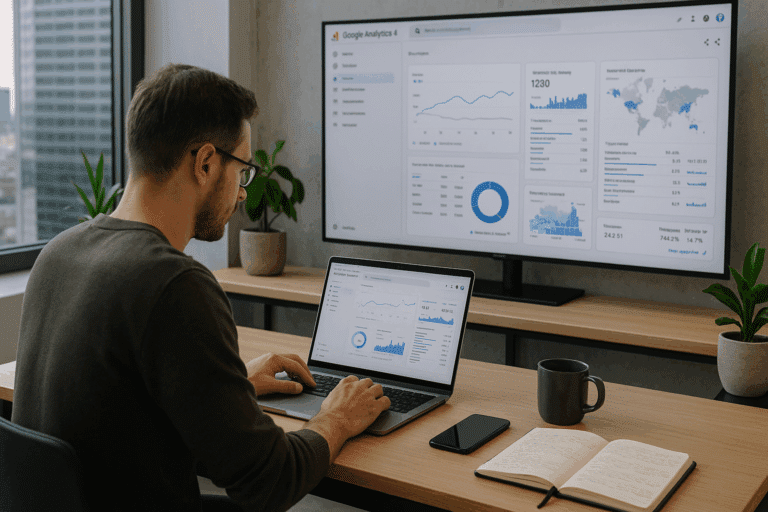For those on a mission to optimize their web assets, a comprehensive understanding of how your users interact with your website is paramount. This is where GA4 (Google Analytics 4) comes in, a powerful tool designed to provide ultimate insights and measurement success. 🎯
Before diving into the nitty-gritty of event tracking with GA4, it’s crucial to first grasp the essence of what event tracking is. In the simplest of terms, event tracking is a method used to capture interactions with website elements such as clicks on a button, form submissions, or video plays. These interactions, or ‘events,’ help paint a more detailed picture of your users’ behaviors and actions on your site.
With the advent of GA4, Google has further enhanced this feature, making event tracking a central part of its analytics platform. GA4’s event-centric approach provides a more granular and detailed view of user interactions, bringing us one step closer to achieving data-driven decision making. 💡
The beauty of GA4 lies in its flexibility and customization possibilities. The one-size-fits-all model of event tracking is a thing of the past. GA4’s automatic and custom events, along with its event parameters and event modification options, offer a level of granularity and specificity unmatched by its predecessors.
What to Expect from this Guide?
Getting to grips with GA4’s event tracking feature can be a daunting task, even for seasoned digital marketers and data analysts. However, this comprehensive guide aims to simplify the process by offering a step-by-step approach to setting up GA4 for ultimate insights and measurement success.
This article will walk you through the basic fundamentals of event tracking, GA4’s automatic and custom event tracking capabilities, and how to use these to your advantage. We will discuss how to set up event tracking, how to create custom events, and how to modify events and event parameters. Also, you will learn how to validate and test your setup to ensure everything is working as it should. This guide is your one-stop resource for mastering event tracking with GA4. 🏁
Who Should Read this Guide?
Whether you are a data analyst, digital marketer, SEO expert, web developer, or business owner looking to better understand your audience’s behavior on your website, this guide is for you. It’s designed to cater to both novices who are just dipping their toes into the world of digital analytics and seasoned professionals who wish to leverage GA4 to its fullest potential.
By the end of this guide, you will have a firm grasp of the capabilities of GA4’s event tracking feature. You will be able to implement and customize your event tracking setup, translate the insights gained into actionable strategies, and ultimately drive your website’s success.
So, let’s get started on this journey towards mastering event tracking and unlocking the power of GA4 for ultimate insights and measurement success. 👍
🚀 Mastering Event Tracking: Setting the Stage for Success
As the digital world continues to evolve at an unprecedented pace, it is more critical than ever to understand user behavior on your platform. This is where Google Analytics 4 (GA4) steps in, offering a robust toolset for event tracking and measurement. By setting up GA4 correctly, you can gain ultimate insights into your users’ behavior, aiding in data-driven decision-making processes.
The power of GA4 lies in its capacity to track and measure events, from page views to user interactions with content like videos or social share buttons. But like any powerful tool, it’s essential to understand how to set it up and use it effectively. This guide aims to walk you through the process, helping you master event tracking for measurement success.
Let’s start at the beginning. What is event tracking? Essentially, it’s a method used in GA4 to understand user interactions with website content. These interactions can include clicks, form submissions, or any other activity that doesn’t involve a new page loading. Before we dive into the step-by-step guide to setting up GA4, let’s first understand the basics of event tracking. The video below, “Understanding Event Tracking in GA4” by Google Analytics, provides an excellent overview of the concept.
Video: Understanding Event Tracking in GA4 (Google Analytics on YouTube)
🎯 Setting Up GA4: The Step-by-Step Guide
Setting up GA4 for event tracking involves several steps. It’s a detailed process that requires careful attention. In this section, we’ll walk you through it, step by step.
First, it’s important to understand that GA4 measures events based on parameters. Parameters are the characteristics of an event, such as the name or value. They can provide additional context about an event, like how long a video was played or the number of items in a shopping cart.
GA4 automatically tracks some events and parameters. However, you can also configure custom events and parameters based on your specific needs. Custom configurations can help you gain deeper insights into your users’ behavior.
1️⃣ Step One: Identify Your Event Tracking Needs
Before you start setting up event tracking in GA4, it’s crucial to identify what you want to track. This could be anything from page views to button clicks to form submissions. Identify the user interactions that are most important for your business, and use these as the basis for your event tracking setup.
📋 Configuring GA4: Automatic vs. Custom Events
As previously mentioned, GA4 can automatically track some events. This means you don’t have to do anything to start collecting data on these events. However, you might want to track additional user interactions that are not covered by automatic events. This is where custom events come in.
Automatic and custom events each have their advantages. The table below compares the two, highlighting their main features and use cases. Understanding the differences between automatic and custom events can help you decide which to use for your specific needs.
| Automatic Events | Custom Events | |
|---|---|---|
| Features | Tracked by GA4 without any additional configuration | Require additional configuration to track |
| Use Cases | Common user interactions like page views, scrolls, and clicks | Specific user interactions that are not covered by automatic events |
2️⃣ Step Two: Configure Automatic Events
Once you’ve identified the events you want to track, the next step is to configure automatic events in GA4. This involves enabling the enhanced measurement feature, which allows GA4 to automatically track certain user interactions.
3️⃣ Step Three: Configure Custom Events
If you need to track specific user interactions that are not covered by automatic events, you’ll need to set up custom events. This involves using the GA4 Event Builder to define your custom events and parameters.
🔍 Understanding and Using GA4 Reports for Event Tracking
Once you’ve set up event tracking in GA4, you’ll want to start using the data to gain insights into your users’ behavior. This is where GA4 reports come in.
GA4 offers a variety of reports that provide insights based on event data. For instance, the Realtime report provides insights into user behavior as it happens, while the Engagement report offers insights into how users interact with your content.
The key to effective use of GA4 reports lies in understanding what each report offers and how it can help your business. The video below, “GA4 Reporting Overview” by Google Analytics, provides a comprehensive overview of GA4 reports and how to use them.
Video: GA4 Reporting Overview (Google Analytics on YouTube)
🔑 Key Takeaways for Mastering Event Tracking with GA4
Mastering event tracking with GA4 can provide valuable insights into user behavior, helping you make data-driven decisions for your business. Here are some key takeaways from this guide:
- Event tracking is a powerful tool for understanding user interactions with your content.
- GA4 offers both automatic and custom events, allowing you to track a wide range of user interactions.
- Setting up event tracking in GA4 involves identifying your tracking needs, configuring automatic and custom events, and understanding and using GA4 reports.
- By mastering event tracking with GA4, you can gain ultimate insights and achieve measurement success.
Remember, this guide is just the beginning. As you continue to use GA4 for event tracking, you’ll discover new insights and techniques. Always keep learning and experimenting, and you’ll become a master of event tracking in no time.

Conclusion
In conclusion, we have traveled a comprehensive journey through the realms of Software Engineering, dissecting the intricate details that make up this vast field. We have delved into the depths of its many facets, intricacies, and subtleties, exploring its vast scope and potential. From understanding the core concepts to appreciating the advanced techniques, we have shed light on the extensive possibilities that Software Engineering holds in this digital age.
One of the key takeaways from our exploration is the realization of the critical role of software engineering in today’s digital-centric world. As our daily lives become increasingly intertwined with technology, the demand for highly competent and skilled software engineers has skyrocketed. The multifaceted nature of this field has proven to be a significant contributor to the technological advancement that our society is witnessing today.
Throughout our journey, we have understood that software engineering is not merely about coding. Instead, it encompasses a wide array of disciplines, including system design, software architecture, quality assurance, project management, and so much more. These varied aspects are what makes this field so challenging and exciting, offering endless opportunities for growth and development.
One of the most significant aspects we have covered is the importance of constant learning and adaptability in this field. As technology continues to evolve at a rapid pace, staying updated and adaptable to these changes is no longer an option, but a necessity for every software engineer.
Furthermore, we have underscored the pivotal role of problem-solving skills, logical thinking, and creativity in software engineering. These are not just skills, but essential traits that every software engineer must possess to excel in their roles.
We encourage you to delve deeper into this fascinating field and understand its vast potential. Whether you are a seasoned professional or a novice enthusiast, there is always something new to learn in software engineering. As we continue to move towards a more digital future, the role of software engineering will only become more crucial, making it an exciting field to be a part of.
So, why not take a moment to share your thoughts and experiences? Your insights can help others gain a broader perspective on this topic. Use the comment section below to share your thoughts and let the conversation flow. And if you found this article useful, don’t forget to share it with your friends and colleagues.
Let’s keep exploring, learning, and growing together in the fascinating world of Software Engineering. Remember, every bit of knowledge you gain is a stepping stone towards your success. Let your journey of learning never cease. 😊
For further reading, you can refer to some of the following resources:
– IEEE Computer Society – Technical Committee on Software Engineering
– ACM SIGSOFT – Special Interest Group on Software Engineering
– “Software Engineering at Google” by Titus Winters, Tom Manshreck, and Hyrum Wright.
Keep learning, keep growing, and stay curious! 🚀
References:
1. IEEE Computer Society. Technical Committee on Software Engineering. Retrieved from https://www.computer.org/technical-committees/software-engineering/
2. ACM SIGSOFT. Special Interest Group on Software Engineering. Retrieved from https://www.acm.org/special-interest-groups/sigs/sigsoft
3. Winters, T., Manshreck, T., & Wright, H. (2020). Software Engineering at Google. O’Reilly Media. Retrieved from https://www.oreilly.com/library/view/software-engineering-at/9781492042754/



